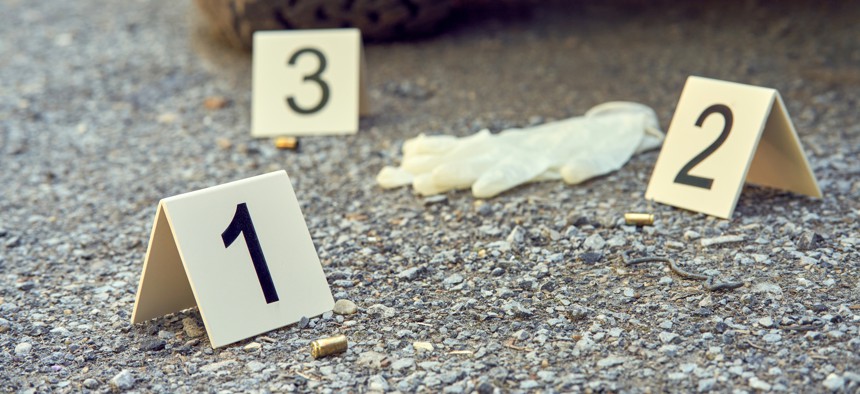ShotSpotter tech takes a hit

GettyImages/LEREXIS
A report from the Surveillance Technology Oversight Project says the gunshot detection system used in 130 cities “fails as an investigative tool.”
A new report blasts the efficacy of ShotSpotter, the gunshot detection technology used in over 130 cities.
“ShotSpotter and the Misfires of Gunshot Detection Technology,” was released July 14 by the Surveillance Technology Oversight Project (STOP), a nonprofit advocacy group fighting excessive surveillance. The report claims that “cities are squandering money on ShotSpotter’s unproven gunshot surveillance technology.”
The ShotSpotter technology locates the source of gunshot based on data from acoustic sensors placed on nearby streetlights or buildings. When the sensors detect a gunshot, ShotSpotter triangulates the location of the shooter from the sensor data and translates that into a street address. Analysts review the data and pass the location of confirmed gunshots to officials who can dispatch police to investigate.
The report says ShotSpotter “fails as an investigative tool, providing no evidence of a gun-related crime in more than 90% of activations in one major study of the tool.” There has been no significant effect on gun crime where it has been installed but, rather, it drains police budgets, consumes officers’ time and contributes to over-policing of Black and Latinx neighborhoods, the report stated.
ShotSpotter has several failings, according to the report:
- The audio sensors do not reliably pick up gunshots, but can record conversations up to 50 feet away, which can later be used in court.
- The proprietary software used to analyze the pop of a gunshot is “a repurposed computer vision program,” which raises questions about its accuracy and reliability in a public safety setting.
- It is unclear how much training is given to the analysts who must determine in less than 60 seconds whether a noise flagged by the technology is a gunshot.
- Claims of 97% accuracy are exaggerated. An August 2021 inspector general report on the technology in Chicago found that police only found evidence of any gun-related crime in 9.1% of calls.
- Classification of a noise picked up by ShotSpotter data can be changed at a police officer’s request. A sound first determined to be a firecracker, then reclassified as a gunshot or moved to a different location can undermine officers in court.
“ShotSpotter may increase police awareness of gunfire (and fireworks and cars backfiring) and the speed at which they know. But that knowledge appears to offer few benefits,” the report said. In fact, it may increase officers’ workload without appreciable results, the report said.
The Chicago study analyzed over 50,000 ShotSpotter alerts and found that more than 90% of dispatches produced no evidence of gun violence. Those 50,000 alerts led to were 244 arrests and 152 recovered guns.
Additionally, because police decide where to place the audio sensors based on local crime data, “ShotSpotter appears to facilitate the same tired logic used to ‘justify’ over-policing” of Black and Latinx communities, the report said.
ShotSpotter officials disputed that claim: “ShotSpotter’s coverage areas are determined by police using objective historical data on shootings and homicides to identify areas most impacted by gun violence to provide residents who live in communities experiencing persistent gunfire a rapid police response,” a company spokesperson said.
The company said that the "STOP report presents false and misleading allegations that the company has previously debunked. Over 80% of gunfire incidents are not reported to police and ShotSpotter enables a fast, precise police response to nearly all outdoor gunfire in the coverage area to help save the lives of gunshot wound victims and capture critical evidence at the scene,” the spokesperson said. “ShotSpotter has a 97% aggregate accuracy rate that has been independently verified. Our privacy protections have been independently audited showing limited risk of voice surveillance and been put to the real-world test with Oakland’s Privacy Advisory Commission, which has twice unanimously approved the use of ShotSpotter.”
“We embrace criticism and respect differences of opinion. Unfortunately, these untrue statements have been unfairly twisted to impersonate facts in the public dialogue about how we help communities improve public safety,” officials said. The company’s website offers a point-by-point response to the report’s major criticisms.
Despite its limitations, many communities have found the technology useful.
In a statement to Bloomberg, the New York City Police Department said that ShotSpotter is “a highly effective crime-fighting tool.” The Chicago Police Department said in a separate statement that “gunshot detection technology has detected hundreds of shootings that would have otherwise gone unreported.”
Police in Syracuse, New York, and the Onondaga County District Attorney’s Office officials said Shotspotter has been a crucial tool in investigating shootings, in trials and in allocating officers since it was installed in 2017. ShotSpotter alerts combined with intel-led policing by the Oakland, California, Police Department, lead to the arrests of six people and a dozen firearm recoveries in less than a week, city officials said.
ShotSpotter data has also been incorporated into Baltimore’s Gun Trafficking Intelligence Platform. The intelligence tool was developed by the Baltimore Police Department and Everytown for Gun Safety, a gun violence prevention organization. It aggregates and analyzes crime gun trace data and ballistics information to identify networks, individuals and entities that might be involved in violent crimes or gun trafficking.
This story was updated July 21 with comments from ShotSpotter.






